Decorating a tiny home can be challenging, but with the right small space home decor ideas, even the coziest apartment can feel spacious and stylish. This blog shares eight practical, design-driven ideas to maximize light, storage, and comfort in compact rooms. We focus on creative solutions like multifunctional furniture, light color palettes, mirrors, and clever storage to make every inch count.
Whether you live in a studio apartment or a small house, the tips below will help you avoid clutter, add personality, and create the illusion of a larger space. From custom-built shelving to neutral tones and indoor plants, each idea is illustrated with examples and expert advice. Read on for a positive, bias-leaning review of these strategies – packed with transition words and active-voice guidance – to inspire your small space home decor.
1. Multi-Functional Furniture Transforms Small Space Decor
A cornerstone of small space home decor is choosing furniture that does double duty. In a tight living area, pick pieces like fold-out tables, sofa beds, or nesting tables to avoid extra bulk. For example, designer MA Allen installed a chess table that “conveniently folds up to free up space” in a game room. That way, one table serves both as a surface for dining or work and tucks away neatly when not in use.
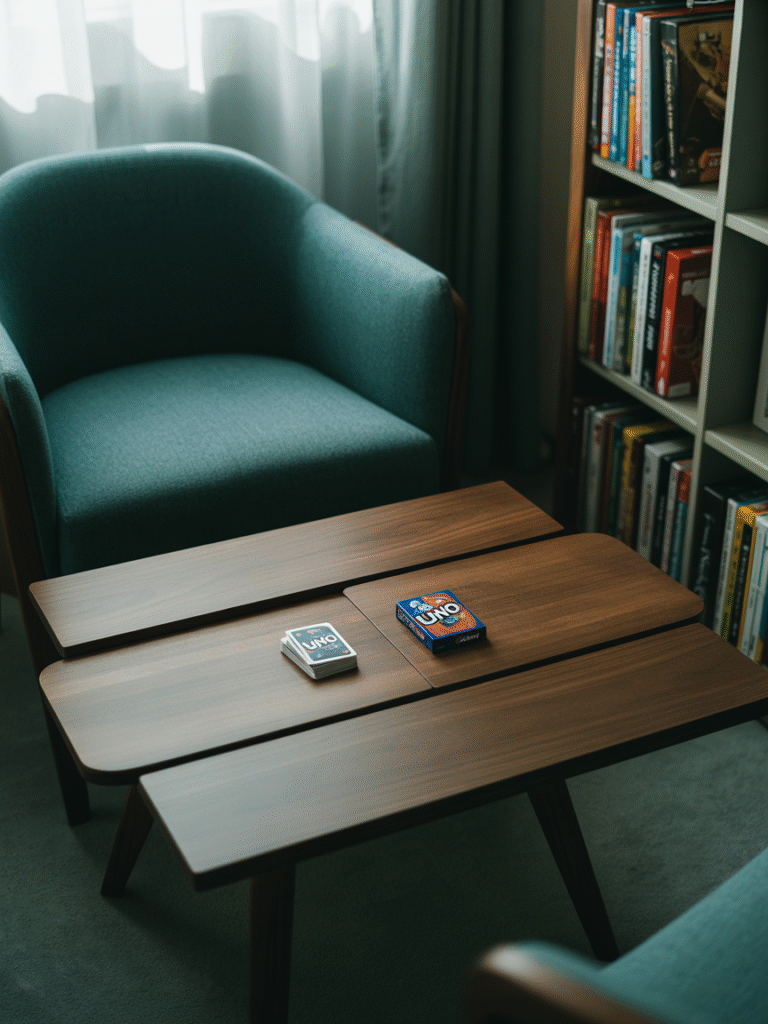
Other smart picks include storage ottomans, wall-mounted desks, and Murphy beds. The IKEA FRIHETEN sleeper sofa (about $899) is a classic budget-friendly choice – it’s a sofa by day and a bed by night, with hidden storage beneath the cushions. When opened, the back cushions unfold into a full-size mattress, and a “handy hidden drawer” under the sofa provides extra storage. In small spaces, every piece of furniture should earn its keep: look for built-in shelves, drop-leaf tables, or sectionals with storage.
Key takeaways: opt for pieces that expand or hide, such as fold-down desks, benches with under-seat bins, or sofa beds. These multifunctional items keep traffic flow open and reduce clutter by eliminating redundant furniture. If you compare top space-saving sofas, you’ll find products like the Ikea FRIHETEN or the Koala Harper Sofa Bed that are designed exactly for tiny living (see comparison table below). Overall, emphasizing function over form lets a small home work harder for you.
2. Maximize Natural Light with Light Colors and Mirrors
Creating the illusion of space often starts with light. Fresh or neutral colors on walls, floors, and ceilings reflect natural light and make rooms feel airy. As one interior expert notes, “all-white and neutral tones” are “easy on the eyes, calming, and uplifting”, helping “make the small room appear bigger and brighter”. Paint your walls in warm whites, beiges, or pale pastels, and choose light-colored rugs and curtains to amplify brightness.
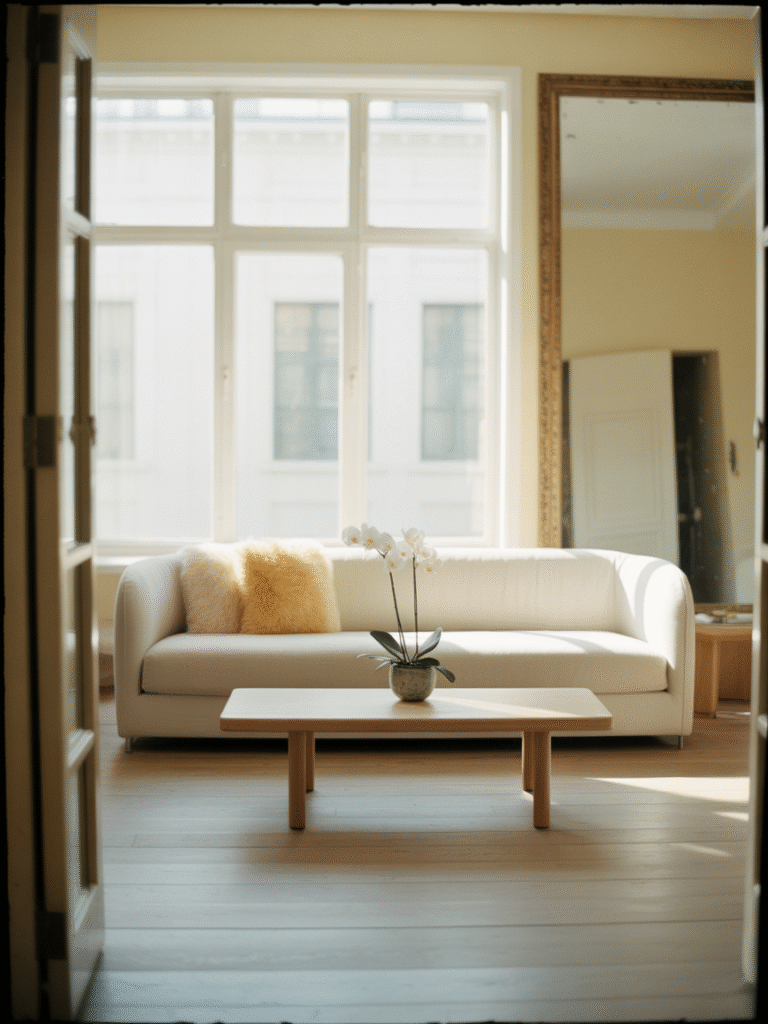
Similarly, strategically placed mirrors dramatically expand visual space. Position a large mirror across from a window to “add depth and light to a room”, effectively doubling the view. The Spruce recommends placing mirrors opposite windows to bounce sunlight around and create the feeling of more square footage. A mirrored wardrobe door or a tall leaning mirror can work wonders in a narrow bedroom or entryway. In short, white paint and reflective surfaces turn small apartments from claustrophobic to open and breezy.
Pro tip: If you’re hesitant about stark white, try off-white or light gray – enough to brighten without feeling sterile. Also consider translucent decor (glass shelves, acrylic furniture) to avoid visual heaviness. As one designer explains: “Open shelving… takes away the visual weight that closed cabinets would, and you can even use glass shelves… letting more light into every aspect of the room“.
3. Creative Storage Solutions Keep Small Homes Clutter-Free
In a tiny home, clutter is the enemy of coziness. Embrace storage strategies that lift belongings off the floor and tuck them away cleverly. For example, turn a sunny bay window into a built-in seat and shelf combo. As one designer did, “a window seat gives guests a place to rest while… low-profile bookshelves keep the floor clear of clutter”. This doubles your seating and shelving in one solution, which is ideal if you’re “short on both seating and storage”.

Similarly, use vertical space everywhere. High-mounted hooks and peg rails keep entryways clear, while tall shelving or cabinets draw the eye upward. Open shelving and glass-front cabinets, as mentioned earlier, maintain an open feel: “open shelving… takes away the visual weight” of closed units. In the kitchen, add floating shelves or a wall rack to store spices and dishes off counters. In bathrooms, mount medicine cabinets above sinks and use slim over-toilet shelves.
And don’t forget multifunctional organizers: ottomans with hidden compartments, beds with drawers underneath, or a dresser doubling as a nightstand. For instance, repurposing a bedroom dresser as a bedside table adds drawer space without extra footprint. The key is “keeping your floors clear,” which instantly makes small spaces feel larger.
4. Embrace Natural Elements and Textures in Small Spaces
Incorporating nature and tactile fabrics adds warmth without shrinking a room. Houseplants, for example, introduce height and life into a corner or tabletop. Designers predict plants will remain popular in small space decor; they explain that succulents, ferns and terrariums “evoke a feeling of calmness” and bring color to compact homes. A single fiddle-leaf fig or a hanging ivy plant can make a bare wall feel intentional.
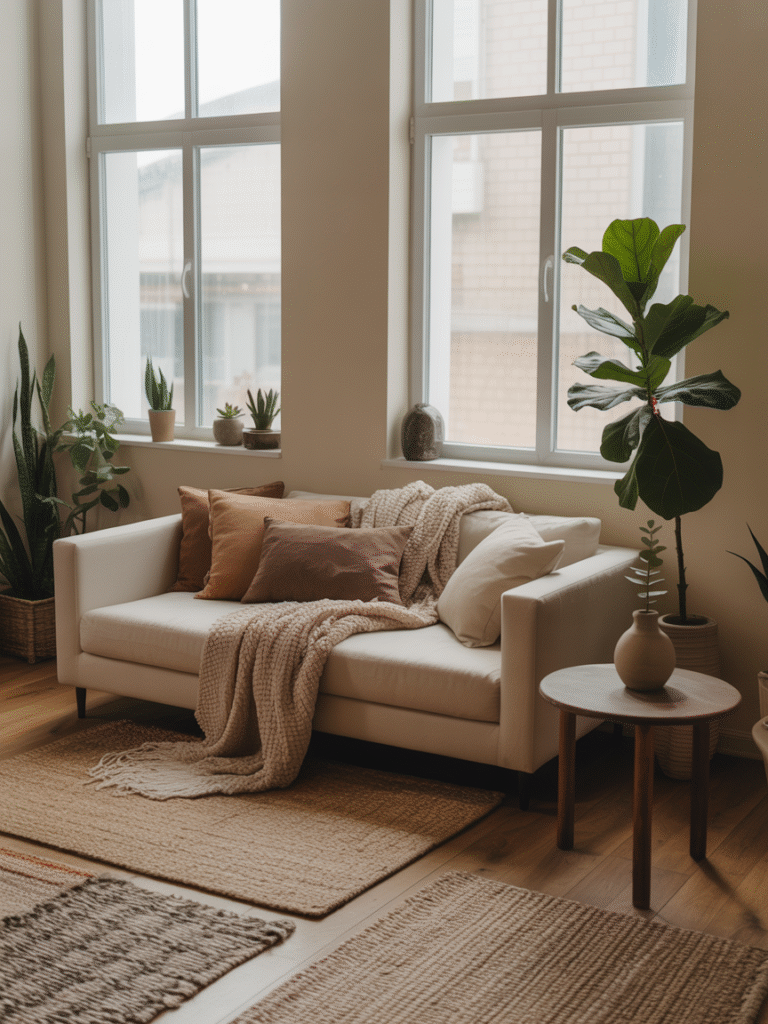
Likewise, rich textures (wood floors, woven rugs, cozy throw blankets) create a layered look that feels more intentional than cluttered. The Spruce advises balancing hard and soft materials: combine wooden furniture or metal accents with soft rugs and pillows to make a small space feel warm. Repeating a few key textures – say a leather pouf matched with a leather chair, or a wool throw on the sofa matching woven baskets – adds cohesion. Even a gallery wall of framed art or woven wall hangings can give visual interest without using precious floor area.
Because natural light and greenery are at a premium in small homes, look for mirrors with bamboo frames, jute rugs, or stone planters to keep the decor theme consistent. These touches reinforce an organic, open-air feel. In short, “indoor plants add a touch of greenery and life to a space,” helping tiny rooms feel fresh.
5. Right-Sized Furniture and Flexible Layouts for Compact Living
An often-overlooked trick: don’t shy away from a slightly larger sofa or table if it fits the space. It sounds counterintuitive, but choosing properly scaled furniture avoids a dollhouse effect. For example, The Spruce notes that sometimes the best small-room sofa is the largest one that will fit; a too-tiny couch can make the room feel disjointed. Similarly, avoid a huge sectional that “engulfs the room”. Instead, pick furniture with a streamlined profile: armless chairs, slim legs, and low backs keep sightlines clear.
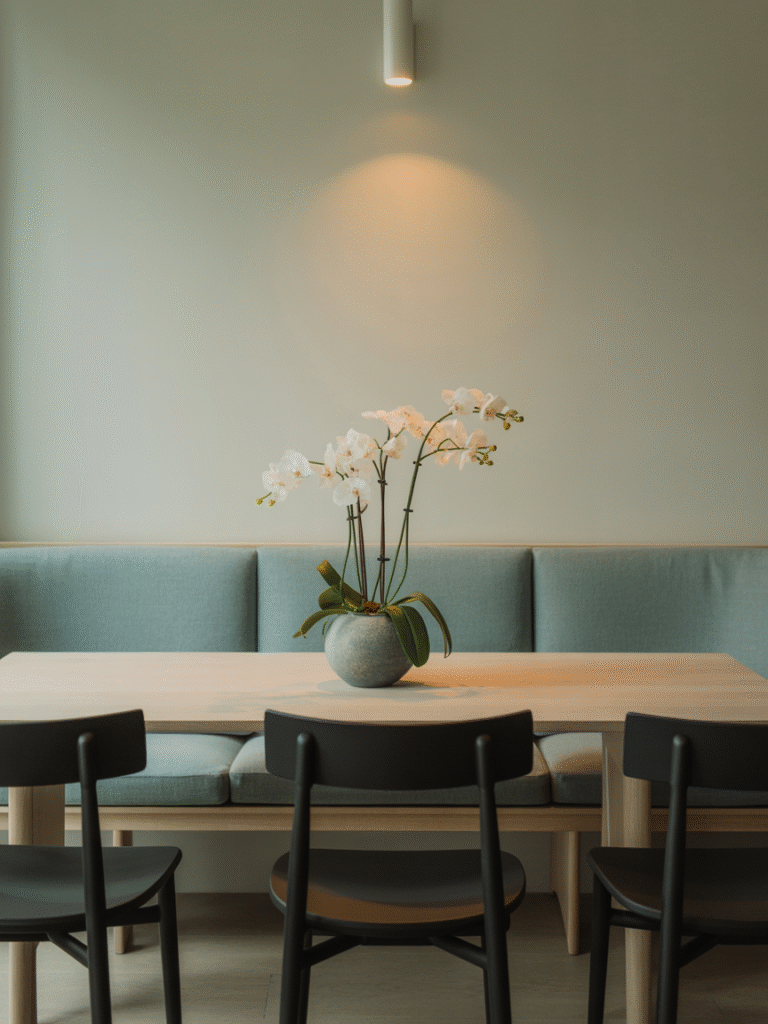
Flexible layouts are vital. Float a corner sofa to define a living area without blocking walkways, or place a round table in a tight kitchen nook to allow flow on all sides. Even placing a corner desk (or bed) can exploit awkward angles. When seating, small poufs or ottomans work as both footrests and extra chairs when guests arrive. As BHG suggests, a pouf is a “great small apartment decor idea”: it can serve as a coffee table, extra seat, or footrest, and often comes with a removable cover for versatility.
Finally, consider space-extending gimmicks: mount the TV on the wall, use clear acrylic furniture, and favor coffee tables with slender legs. These choices free up floor area. And of course, a Murphy bed or fold-down table can physically open up an entire room on demand. By paying attention to scale and having flexible furniture, your small apartment can remain functional and uncluttered.
6. Add Style with Accent Pieces and Personal Touches
Small space decor shouldn’t feel sterile – inject personality with a few bold accents. A single large piece of art can actually make a small wall feel bigger than many tiny frames. Don’t fear color or pattern; a bright throw pillow, an interesting rug, or a gallery wall of pictures can serve as the focal point. In fact, painting stripes or a feature wall can add height or depth. Just keep decorative clutter minimal. For instance, the Spruce recommends one large artwork instead of many little ones: “One large striking canvas will create the impression of a more spacious room than a bunch of small pieces.”
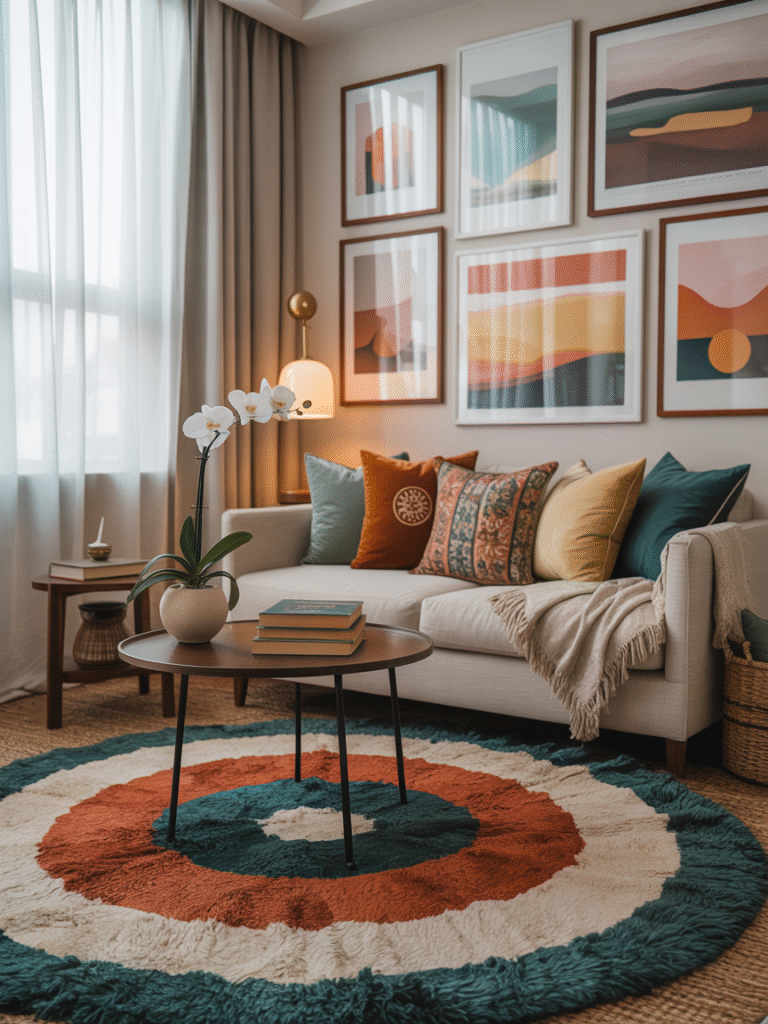
Rugs and lighting are also key accents. A cozy area rug anchors the space and keeps it from feeling cavernous. Hanging a pendant light or track lighting frees up floor lamps and draws the eye upward. Even upgrading hardware (fun knobs or pulls) or using textured wallpaper on one wall can add depth. The idea is to make the decor feel intentional without adding bulky items.
By mixing in your personal style – your favorite colors, patterns, and objects – the space will feel homey. But always edit carefully: use baskets and boxes to hide less attractive items and display only a few cherished objects. This keeps the room from feeling crowded. In summary, pick a few statement accents and let them shine in your small space.
7. Utilize Nooks, Corners, and Unused Space
Even the odd corners and alcoves in a tiny home hold potential. Turn a forgotten corner into a mini office with a wall-mounted desk, or create a reading nook under a staircase. As one designer noted, even a powder room needed making use of all corners, so a corner sink saved space and added charm. Similarly, tuck shelves above doorways or a corner wall for books and decor.
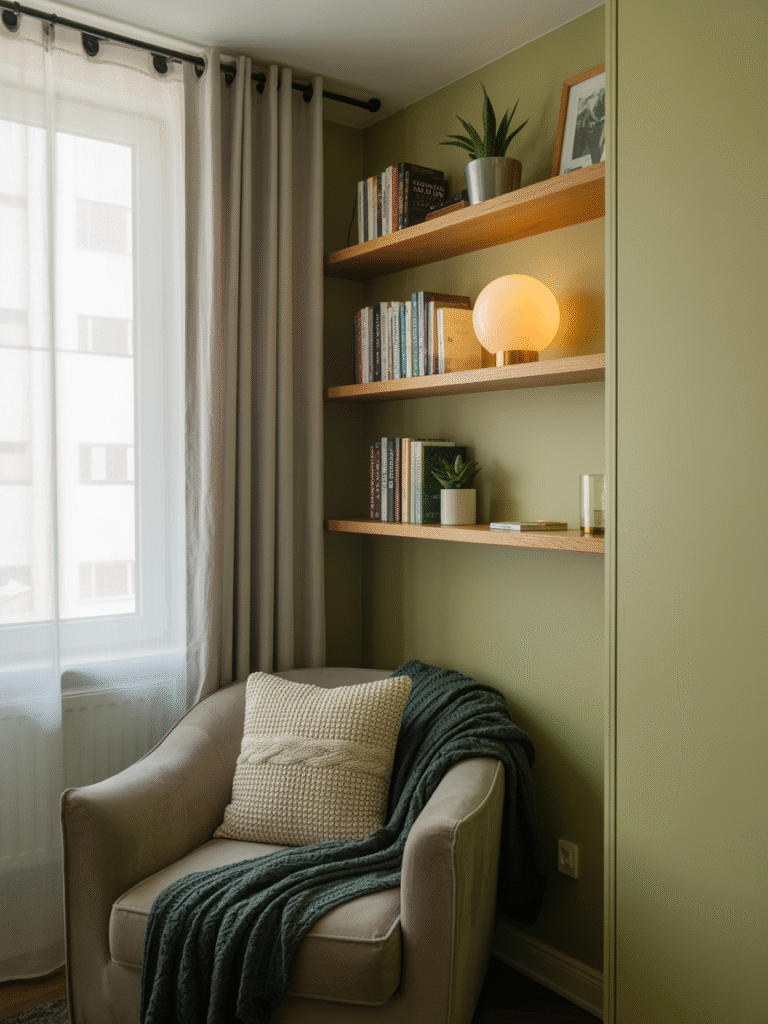
Open shelving is a repeated theme: not only does it look lighter, it also uses vertical wall space effectively. In the kitchen, hanging pot racks or magnetic spice strips free up cabinets. Even in the bathroom, tiered shower shelves and over-the-toilet racks can multiply your storage. The house’s tiny bits – above-the-door storage, under-stair drawers, or the often-unused space above kitchen counters – all deserve a second glance.
By carving out these nooks and customizing them (think a built-in bench, a narrow console, or a floating vanity), you’re maximizing every square foot. This approach is proactive and creative, and it truly makes a big difference in small homes.
8. Keep It Organized and Clutter-Free (Less Is More)
Finally, the mantra of small space design is “less is more.” A minimalist mindset ensures that every item in the room has a purpose. Frequent purging of unnecessary belongings keeps surfaces clear and airflow open. According to organizers, focusing on function over style (with only a few decorative items) helps make a home easy to live in. Constantly look for ways to hide clutter: use baskets on shelves, close closet doors, and hang items on walls instead of piling them.
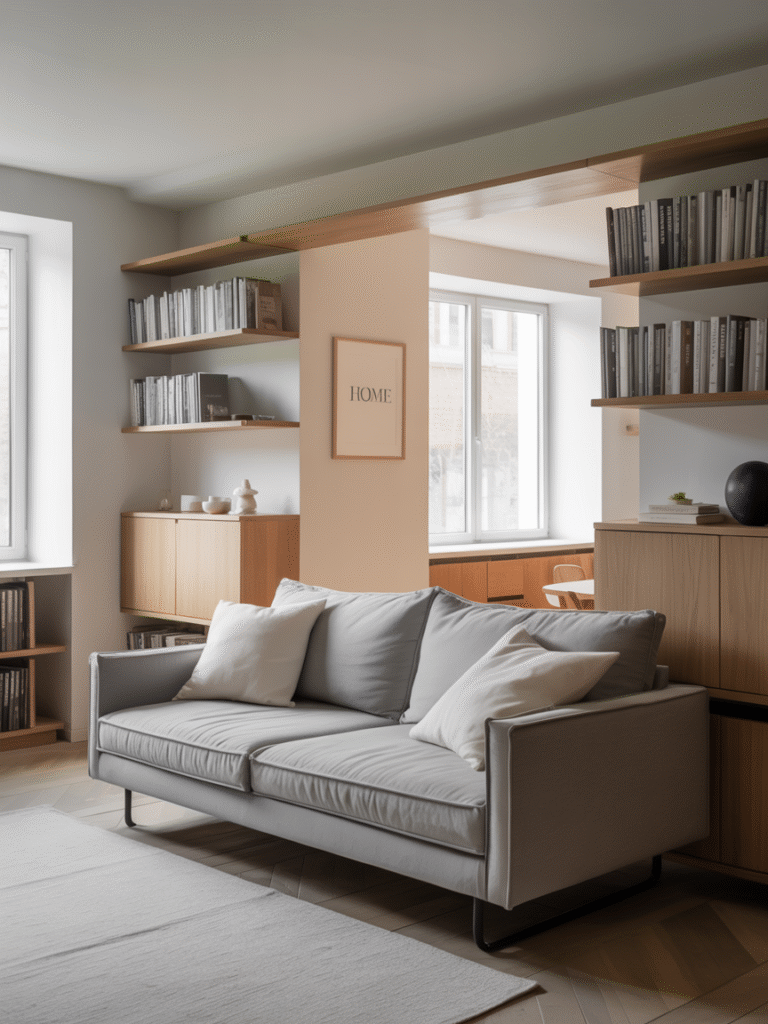
When everything is streamlined, even a tiny room feels tranquil. By combining all these ideas – multifunctional furniture, light colors, mirrors, and smart storage – you can transform even the smallest living room or bedroom into an inviting sanctuary. The result will be a home that looks and feels much bigger than its actual square footage.
Final Thoughts: Small Spaces, Big Style
These small space home decor ideas prove that you don’t need a big home to have big style. By choosing furniture that works hard, embracing light and natural touches, and keeping things organized, your tiny apartment can be both functional and beautiful. Remember, successful small-space design is all about smart solutions – like fold-away tables, benches instead of bulky chairs, and mirrors to bounce light – that open up your rooms. With a positive, can-do approach, your compact home can look just as thoughtful and curated as a large one. Now go ahead and apply these tips: you’ll be amazed how “large” your small space can feel!
Frequently Asked Questions
Q: How can I make a small space look bigger?
A: Focus on light and reflection. Use a neutral color palette and maximize natural light by keeping curtains open. Place mirrors opposite windows to create the illusion of depth. Also, use multi-functional furniture and built-ins to keep the floor clear, which makes a room feel more open.
Q: What type of furniture works best in small apartments?
A: Choose pieces with multiple uses: e.g., a sofa bed, a coffee table with storage, or a wall-mounted desk. Avoid oversized items. Instead, pick slim-profile or armless sofas and chairs, and consider benches instead of separate dining chairs. Even a larger sofa that fits well can make a space feel cohesive (as long as it doesn’t block pathways).
Q: Any tips for decorating small spaces on a budget?
A: Absolutely! Shop thrift stores or budget-friendly retailers for secondhand furniture (vintage finds are on-trend) and paint. You can also DIY floating shelves, use baskets for cheap storage, and add low-cost elements like plants and rugs. Remember, a fresh coat of light-colored paint and better lighting are affordable upgrades that instantly lift a small room’s look.
Q: How should I arrange the furniture in a tiny living room?
A: Place furniture against walls to open up central space. If possible, float larger pieces (like a sofa) away from windows or corners to maximize flow. Use modular seating (like a sectional that fits a corner) and accent chairs or poufs that can be easily moved. Keep pathways clear and consider multifunctional layouts (e.g., dining table doubling as desk).
Q: Are there small space decorating trends I should know for 2025?
A: Trending ideas include less extreme maximalism, meaning you can still express style but in a curated, thoughtful way. Neutrals remain popular to brighten small rooms, as do natural elements – houseplants and botanical prints are on trend. Mirrors and light wood tones are also favorites for keeping small spaces airy. Embrace these trends while ensuring every item serves your lifestyle.
The key to any small space is to prioritize functionality without sacrificing personal style. With these creative small space home decor ideas, you can confidently make your compact home look stylish, practical, and welcoming.

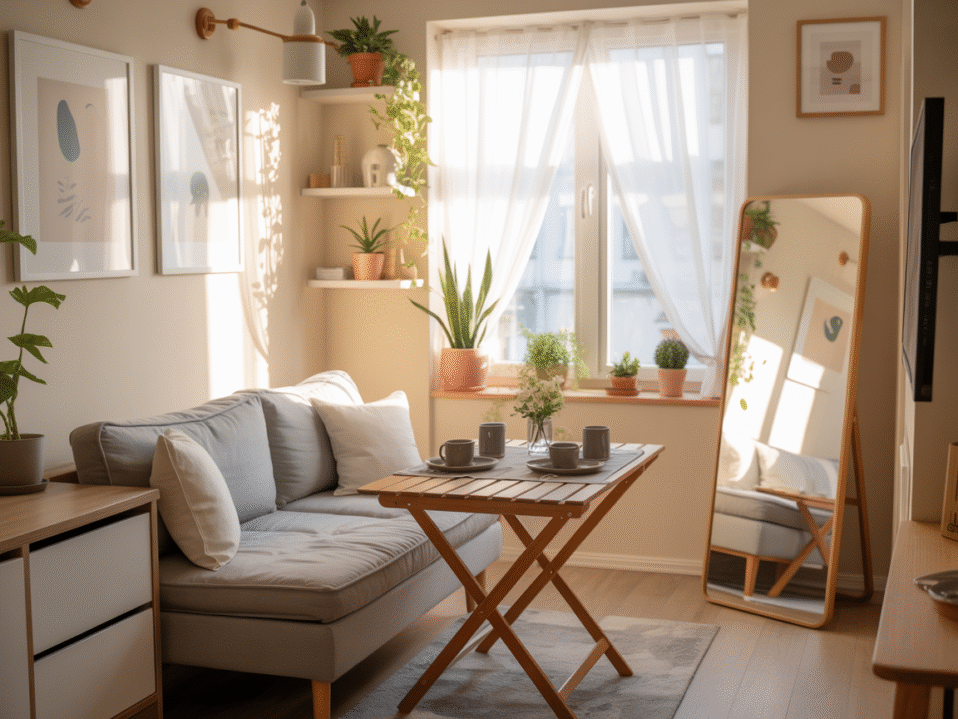

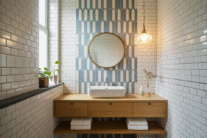
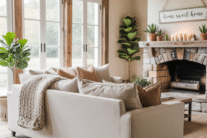
Post a comment